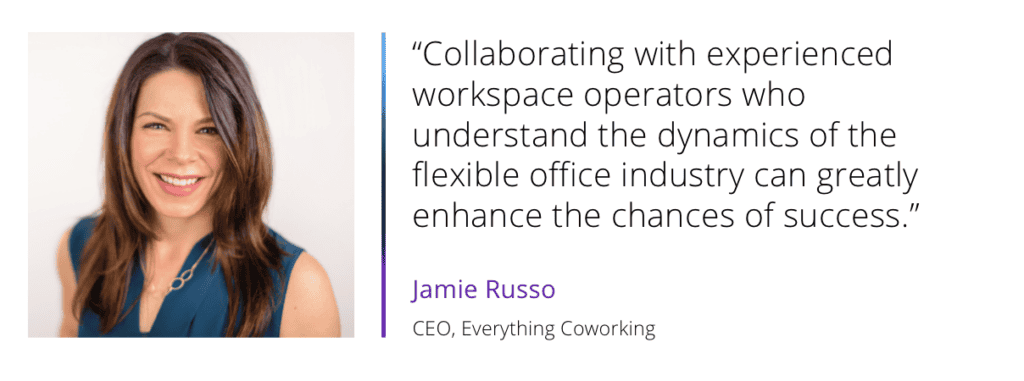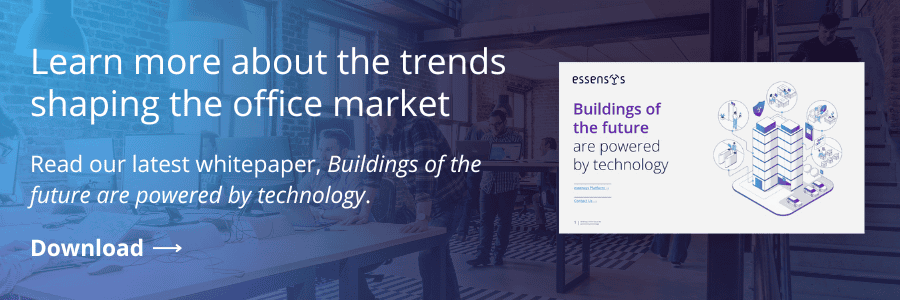Table of Contents
Jamie Russo, CEO, Everything Coworking, shares her insights on flexible workspaces, as part of our series into the buildings of the future.
What keeps you up at night? Tell us about the biggest pain points you encounter when implementing flex space/looking at your flex strategy.
One core challenge of the growth of the flexible office market that keeps me up at night, is that the source of new inventory will predominantly come from landlords who are great at providing a “choose your own adventure” white box solution and now have to offer a complete and compelling workspace product.
When considering flex strategy, these are the biggest pain points:
Transitioning to a flex model
The traditional model involves long-term leases with fixed rental income, whereas the flexible office model is really a customer acquisition model. It requires getting “butts in seats” each month with churn that is at least annually or could even be monthly.
Providing more than a desk
I always say that this is a very simple business model, but it’s easy to screw it up. Creating a successful flexible offering relies on factors such as location, design, amenities, hospitality, and services. Offering workspaces that succeed on these dimensions typically require a new competency and new team members with these skills.
Collaboration is key
Landlords should carefully consider the “build/buy/partner” decision when determining how they will add flexible offerings to their portfolio.

However, identifying and selecting the right partner is not without its challenges. Landlords should conduct thorough due diligence to assess the track record, expertise, and reputation of potential partners. They must find operators who align with their vision and goals, possess the necessary operational capabilities, have a deep understanding of the target market, and will approach the partnership opportunity with complete transparency.
Read more insights from the industry experts:
Part 1 with Faye Stutts, National Director of Coworking Partnerships, Vari.
Part 2 with Davey Friedman, Vice President, Real Estate at Arch Amenities Group.
Part 3 with Mark Burge, President, Flex Workspace Solutions.
Part 4 with Michael Kloppenburg, Vice President, Avison Young.
Part 6 with Liz Elam, Founder of GCUC Global.
 |Jamie Russo, CEO, Everything Coworking, shares her insights on flexible workspaces, as part of our series into the buildings of the future.
|Jamie Russo, CEO, Everything Coworking, shares her insights on flexible workspaces, as part of our series into the buildings of the future.
What keeps you up at night? Tell us about the biggest pain points you encounter when implementing flex space/looking at your flex strategy.
One core challenge of the growth of the flexible office market that keeps me up at night, is that the source of new inventory will predominantly come from landlords who are great at providing a “choose your own adventure” white box solution and now have to offer a complete and compelling workspace product.
When considering flex strategy, these are the biggest pain points:
Transitioning to a flex model
The traditional model involves long-term leases with fixed rental income, whereas the flexible office model is really a customer acquisition model. It requires getting “butts in seats” each month with churn that is at least annually or could even be monthly.
Providing more than a desk
I always say that this is a very simple business model, but it’s easy to screw it up. Creating a successful flexible offering relies on factors such as location, design, amenities, hospitality, and services. Offering workspaces that succeed on these dimensions typically require a new competency and new team members with these skills.
Collaboration is key
Landlords should carefully consider the “build/buy/partner” decision when determining how they will add flexible offerings to their portfolio.

However, identifying and selecting the right partner is not without its challenges. Landlords should conduct thorough due diligence to assess the track record, expertise, and reputation of potential partners. They must find operators who align with their vision and goals, possess the necessary operational capabilities, have a deep understanding of the target market, and will approach the partnership opportunity with complete transparency.
Read more insights from the industry experts:
Part 1 with Faye Stutts, National Director of Coworking Partnerships, Vari.
Part 2 with Davey Friedman, Vice President, Real Estate at Arch Amenities Group.
Part 3 with Mark Burge, President, Flex Workspace Solutions.
Part 4 with Michael Kloppenburg, Vice President, Avison Young.
Part 6 with Liz Elam, Founder of GCUC Global.